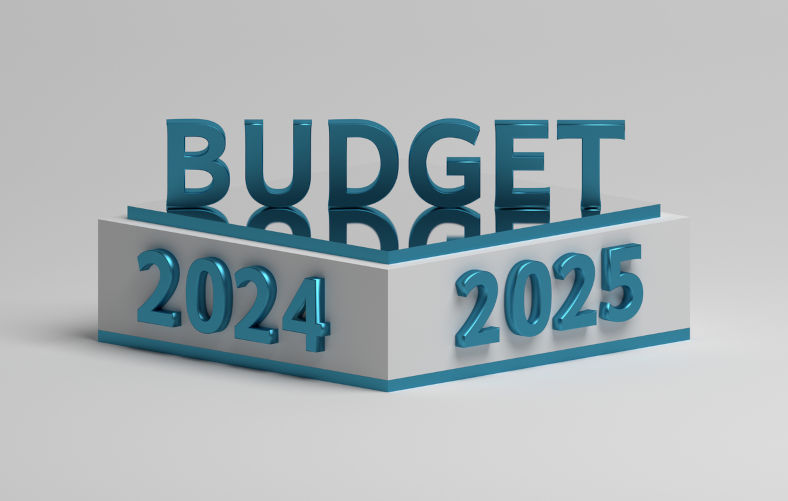After considering Opposition criticisms, this article concludes that this Budget reflects Labor’s competent economic management. However, a more ambitious tax reform agenda is needed to adequately provide all the services that Australians expect.
Labor’s macroeconomic strategy
Essentially Labor faced a difficult balancing act with this budget. The challenge was to improve the cost of living without adding to inflation, and to reduce inflation without a recession and a substantial increase in unemployment.
In fact, there is a reasonable prospect that the cost of living will be less of an issue next financial year, as Treasury is forecasting that real disposable income will grow by 3½ per cent in 2024-25. This is expected to be driven by a 2½ per cent growth in labour incomes and a 1 percentage point contribution from the government’s rejigged Stage 3 tax cuts.
Economic growth is however subdued, with real GDP forecast to increase by only 1¾ per cent in the current financial year (2023-24), and not much faster in 2024-25 (2 per cent) and 2025-26 (2¼ per cent). This actual rate of growth is a bit less than the potential growth rate of output, and consequently unemployment is forecast to rise a little to 4½ per cent by the June quarter next year.
Excess demand should not therefore present a problem. But in addition, the Government has sought to put further downward pressure on inflation by providing energy bill relief with an annual $300 rebate, increasing the subsidy for pharmaceuticals so that there will be no price increase, and increasing rent assistance, all of which will lower the rate of increase in consumer prices as measured by the ABS.
The fact is that inflation has already moderated substantially under the Labor Government and is currently less than half its peak of 7.8 per cent over the year to December 2022. Treasury now thinks that with the help from the Government’s cost of living measures inflation could return to the Reserve Bank’s target band of 2-3 per cent by the end of 2024.
Furthermore, for many people a key part of the increase in their cost of living has been the increase in interest rates over the last two years. In particular, the ABS has found that that the cost of living for an employee on average rose by 6.5 per cent over the twelve months ending in the March quarter of this year, whereas the CPI increased by only 3.6 per cent. This difference mainly represents the impact of mortgage repayments on employees’ cost of living.
By comparison, the ABS found that over the same period ending in March this year, the increase in pensioners and self-funded retirees living costs was not much more than half the increase for employees. The reason for this difference is that pensioners and retirees are much less likely to have a mortgage than employees, and this consequent difference in living costs underlines the significance of the interest rate rises for most working families’ living costs.
So, getting interest rates down is critical for both living standards and for the Government’s electoral prospects. But the only way to get the Reserve Bank to reduce interest rates is to get inflation down, and Treasury estimates that the expanded energy bill relief to all households and the further increase in rent assistance will directly reduce headline inflation by around ½ a percentage point in 2024-25 without adding to inflationary pressures in the economy.
Nevertheless, the Opposition and some economists have particularly criticised these budget subsidies aimed at reducing inflation, arguing that the Government cannot subsidise its way to lower inflation. Instead, they contend that these measures will increase incomes and therefore demand, and thus put pressure on the Reserve Bank to keep interest rates higher for longer.
First, it is somewhat surprising that the economists who criticise the government for spending to reduce some prices, never made that criticism when the Hawke Government reduced tariffs which reduced the price of motor vehicles for example, and thus added to incomes back then. So what’s the difference between now and then?
But second, and more importantly, even if increased subsidies for some services could add to inflation, that would only be significant if there were excess demand. So far this year, however, retail sales have been falling, and as Treasury says, “labour market conditions are softening”.
In present circumstances, it is doubtful that consumers will go on a spending spree in response to this small amount of extra assistance. Indeed, Treasury thinks “there is risk that household consumption may not respond as quickly as expected to the anticipated recovery in real disposable incomes, particularly if households, facing budget constraints, instead seek to replenish savings or if employment growth is slower than forecast.”
In sum, the Government has a good prospect that it has managed to maintain a reasonable balance between its three main objectives: improving the cost of living, reducing inflation, and without causing a recession and an unacceptable level of unemployment.
Government spending
The other main line of Opposition criticism of the budget is that Labor’s spending is too high, with the counterpart that taxes will always be lower under a Coalition government.
It is fair to say that in this Budget, Labor has spread it assistance widely. Just about every deserving case has received some increase in assistance, with the notable exception of the more than one million people trying to survive on JobSeeker, Youth Allowance, and related payments of $55 or less a day.
The assistance for these poorest Australians remains unchanged, despite Australia having the lowest rate of unemployment benefit in the OECD and an increase in assistance for these people being widely supported, including by the Government’s own Economic Inclusion Advisory Committee.
But Labor is clearly determined to only spend what it thinks the economy can afford. As the Treasurer put it, the Government is charting “a responsible middle course between those who want us to slash and burn in the budget, and those who think that it should be some kind of free-for-all of spending.”
So Labor has increased spending, but it has been restrained. Since last year’s 2023-24 Budget was announced, Labor’s new policy decisions have added a total of $30,638 million to budget outlays over the four years from 2023-24 to 2026-27.
That is an increase of only 1.0 per cent spread over four years, which arguably is not much, given the extent of underfunding by the previous Coalition Governments of most government services.
Alternatively, a longer-term view of Labor’s total spending, not just recent new policy, shows that post the impact of Covid funding, over the five years from 2022-23 to 2027-28 total government spending is projected to grow at an annual average rate of 2½ per cent. Again, this is still quite low, but it is front-loaded with government spending rising fastest in the first two of these five years, and future budgets may add more again to the later years.
The Opposition, for its part, is also pointing to the fact that government payments are projected to rise to 26.4 per cent of GDP in the forthcoming 2024-25 financial year and to 26.6 per cent of GDP in 2025-26. Except for the Covid years this would be the highest level of government spending in more than fifty years.
But rather than citing these various statistics in a vacuum, we need to address what is being done with this money and how much do we really need to spend on publicly funded services, compared with the alternative of more private consumption.
There is a stack of evidence, including from Royal Commissions, that many public services such as health, aged care, education, childcare, social housing and income support were all significantly underfunded by the Coalition Governments in their failed attempt to get the “budget back into the black” without a tax increase.
Indeed, if we look at what other similar advanced democracies spend on government services we find that Australia is way down near the bottom. Thus, the OECD reports that total government spending by all levels of government in Australia in 2023 was 37.7 per cent of GDP, compared to an OECD average of 43.1 per cent of GDP. The only countries lower than Australia were Korea and Switzerland, with even the United States spending more at 40.1 per cent of GDP.
If the critics of government spending are fair dinkum, they should be made to nominate where they could make savings, but they never will because they know that they can’t.
The only Coalition Government which did try to make the policy changes need to achieve major savings, was the Abbott Government in its first budget in 2014. But those policy changes were rejected by the electorate and subsequently withdrawn. Ever since Coalition governments have not been game to make significant policy changes to save money, and instead have relied on underfunding numerous programs, which has never worked.
In fact, we have to go back to the Hawke Government to find a government which deliberately introduced policy changes to make major budget savings. During that period, the Hawke Government introduced much greater means testing of benefits and other assistance. As a result, real government spending fell in each of the three years 1986-87, 1987-88, and 1988-89, but ever since no government has come up with a significant acceptable alternative to reduce budget spending.
Indeed, in his Budget Reply Speech, the Leader of the Opposition, Peter Dutton, talked about everything except the Budget. His only proposal to reduce government expenditure was to reduce the number of public servants and to cut the funding for Labor’s Future Made in Australia program.
Reducing the number of public servants will not lead to much if any savings. Many of Labor’s additional public servants are replacing more expensive and less competent private consultants and the others are restoring services by reducing ridiculous waiting times.
Also, while the efficacy of the Future Made in Australia funding is contentious, the total funding is only $22.7 bn over the next ten years, of which only $2.75 bn will be spent in the next four years and most of that is in the latter two years. Consequently, wiping out the Future of Australia funding would have no significant impact on the projected budget deficits of $35 bn and $36.6 bn in each of the next two financial years.
Conclusion
While Albanese claimed on Monday that this is “a Labor budget through and through”, there are many potential Labor supporters who would love to see a greater effort to restore the funding damage done by the Coalition government over the previous nine years.
The Government has certainly proved that it can be trusted to be responsible and competent, but some will continue to pine for greater ambition. Of course, greater spending would only be responsible with increased revenue, but right now it would be good to see Labor preparing the ground for tax reform directed to raising sufficient revenue to pay for the services that we want and need.
And the best place to start would be to introduce a carbon tax which leading economists, Garnaut and Sims, estimate could raise well over $100 billion or about 4 per cent of GDP in its first year. Plenty of money could thus be found to fix Australia’s budget problems as well as being the most efficient way to reduce carbon emissions.
Michael Keating is a former Secretary of the Departments of Prime Minister and Cabinet, Finance and Employment, and Industrial Relations. He is presently a visiting fellow at the Australian National University.

